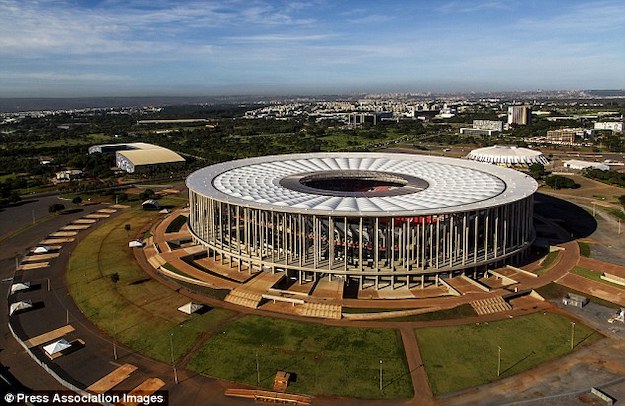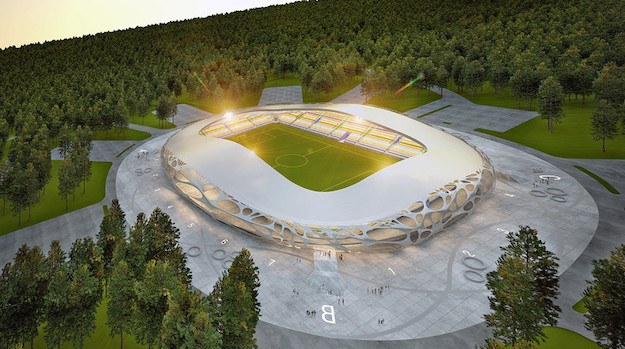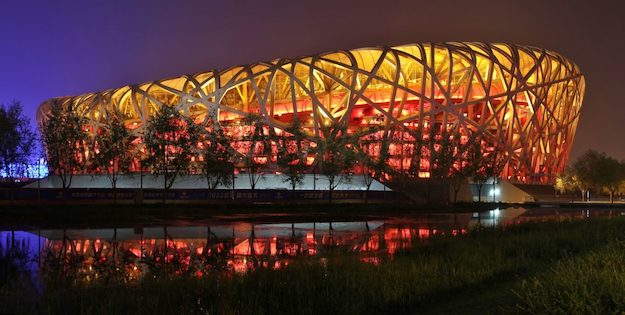The football clubs found, in their stadiums, a way to stand out and the most prestigious architects on the planet knew how to take advantage of this opportunity to design spectacular buildings that distance themselves from the monotony of stadiums and traditional buildings, and that also allows them to demonstrate their experience making them known worldwide.
It sounds strange, but many football stadiums receive more visits than art museums. And not necessarily when they are celebrating a sporting event, but because, due to their architecture, they have become icons of their cities, becoming a mandatory stop on any tourist tour and attracting thousands of people to visit and photograph them.
Mane Garrincha National Stadium – Brasilia Brazil

The identity of Oscar Niemeyer’s works with the unmistakable pillars that take over the facades and create a large veranda at the Planalto, Justice, Itamaraty and Alvorada Palaces served as inspiration for the National Stadium of Brasília, popularly known as Mané Garrincha.
The metal structure with the cables received a PTFE membrane – fiberglass and teflon – supported by a ring, 22 m wide and 1 km long.
Also according to the architect, “the roof works like a big hat “- a Mexican sombrero, which casts the shadow and provides comfort to the people who will be inside the stadium. This cover is purposefully positioned above the last step of the grandstand, allowing the passage of constant wind.
It is worth mentioning that the central part of the roof – which reaches 83 m in diameter – will subsequently receive a retractable system (opening and closing) supported on the fixed part of the structure, with fixed and sliding steel cables. The material chosen for this stretch will be a flexible membrane of high resistance and durability, composed of fiberglass mesh covered with high performance vinyl.
FC Bate Borisov Football Stadium

Five years after the construction started, the Belarusian FC Bate Borisov stadium was ready. Inspired by the architecture of the cells, it was designed by the Slovenian atelier OFIS Arhitekti’s and is surrounded by organic aluminum exoskeleton, with drop-shaped openings.
With a capacity for 13,000 spectators, says Inhabitat, the stadium also has a VIP, commercial and office area. The stadium is located south of the city center and is surrounded by large areas of forest.
The complex’s rounded shape optimizes the acoustics, which allows amplifying the noise of the crowd during games. In addition to the forest, the space is also surrounded by 914.4 square meters of pedestrian zones.
Five years after construction started, the Belarusian FC Bate Borisov stadium was ready. Inspired by the architecture of the cells, it was designed by the Slovenian atelier OFIS Arhitekti’s and is surrounded by organic aluminum exoskeleton, with drop-shaped openings.
Beijing National Stadium – Beijing, China
This magnificent stadium, popularly known as “Bird’s Nest” for the tangle of twisted pieces of metal that make up its architecture, was built with the main objective of being the main stage of Olympic athletics, opening and closing ceremonies, and some games of the Beijing 2008 Olympic Football Tournament.
The Stadium designed by the Swiss architects Jacques Herzog and Pierre de Meuron, in collaboration with ArupSport and China Architecture Design & Research Group was the winner of the international competition, held in 2002, precisely thanks to the original proposed solution, inspired by the plot of a nest and formed by a myriad of intertwined branches and that managed to impress a jury of professionals who were an impressive part like Koolhaas, Nouvel, Perrault. The project had a budget of US $ 500 million.
The Beijing Olympic Stadium was, according to the architects “a brilliant structural aesthetic challenge”

